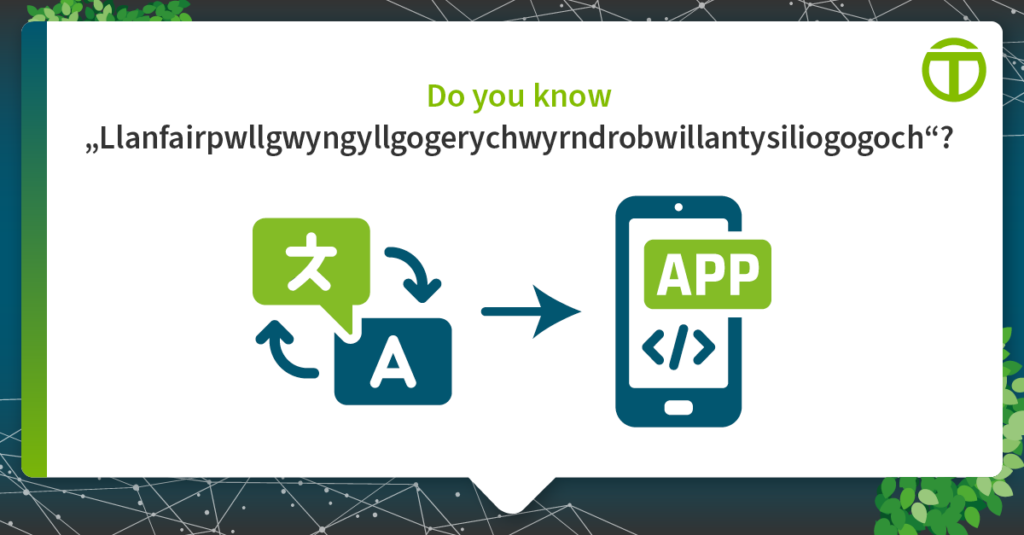Just under nine million apps currently compete for our attention in the digital stores of Apple, Google, and other platform providers. Worldwide. Wherever the internet is available. In dozens of languages. For this reason alone, success in the app charts is directly linked to availability in the respective native language of users. However, the translation is more than just a linguistic challenge.
Have you ever visited the Welsh town of Llanfairpwllgwyngyllgogerychwyrndrobwllllantysiliogogogoch? Probably not. But assume for a moment that you want to spend your next vacation in Llanfairpwllgwyngyllgogerychwyrndrobwllllantysiliogogogoch, perhaps to photograph the town sign. And you want to travel there by car. So, you open Google Maps on your smartphone and search for Llanfairpwllgwyngyllgogerychwyrndrobwllllantysiliogogogoch. However, you will find the (also not particularly intuitive) abbreviated form of the town name: Llanfairpwllgwyngyll. The app uses this form of the town name because it wouldn’t have enough space to display the full name.
For many of us, apps are like a window to the world. They help us navigate directly from our smartphone, order food or a taxi, communicate with others, and even keep boredom at bay. Ideally, technology should allow us to overcome all borders – be they physical, linguistic or cultural.
However, these windows to the world, the screens on our smartphones, only measure a few square inches. As a result, the user experience is strongly influenced by our ability to find our way around this virtual space intuitively, get to grips quickly with the user navigation, and communicate with the system.

Many languages, limited space
This brings us back to the topic of languages and their fascinating characteristics – and the very specific challenges involved in translating and localizing apps.
On the one hand, we have the space restrictions mentioned above, which can have different consequences depending on the language. The concise instruction “Register here” in English becomes the rather longer phrase “zarejestrować się tutaj” in Polish.
However, space is not the only limiting factor. Since most apps are released in the universal language of English, it often requires a clever linguistic workaround to translate them.
Agriculture is wide of the mark
Are you familiar with the game “Clash of Clans”? As you might have guessed from the name, this is not a game that promotes the peaceful coexistence of different nations. In fact, the object of the game is to build a village and train armies so that you can fight against other players and plunder their villages. An essential tool in the game is called “farming”. The direct translation of this in German, for example, is “Landwirtschaft”. However, the specific activity in this case is not agriculture but a process of accumulating resources and developing one’s village to prepare for raids on neighboring villages. So if the vendor of “Clash of Clans” was to add a button called “Landwirtschaft”, this would probably mislead many German-speaking users and cause them to fall out of the point rankings. At the same time, a more accurate translation such as “Ressourcensammlung” (accumulating resources) would not be a particularly attractive linguistic solution in the app. Do you want to know how the problem is solved in “Clash of Clans”? The result may surprise you. Find out for yourself!
Translating apps requires more than just dealing with language. It is an interdisciplinary process. Successful translations in this genre rely on a combination of linguistic knowledge, technical understanding, design expertise, and intercultural know-how. One only has to think of messenger services such as WhatsApp and the fact that speakers of Arabic and Hebrew read from right to left. This has consequences for the layout because the interactive elements and texts must be sufficiently adaptable so that they also look good in other writing systems.
Do translations even pay off?
This all sounds terribly complicated. But does the effort required to translate and localize apps actually pay off?
Let’s start by answering the question from a brand perspective: even if people speak different languages and use apps in different languages, they expect all language versions to deliver a consistently good user experience and a degree of familiarity. It’s a little like fast-food chains: we expect a cheeseburger from the branch in New York to at least look similar to the one in Berlin. The consolidation and consistency of the brand identity is therefore directly linked to the quality of translations and their integration into the UX design. UX design attempts to optimize the user experience of an app – for instance, through the design and layout of buttons or menu navigation.
How translations can push apps
The commercial benefits of an intelligent translation can also be expressed in figures. When China first set out to become a major digital power more than a decade ago, apps that offered a Chinese version were much more popular than those that were only available in English. As early as 2012, almost 80 percent of the 200 most popular apps in Chinese online stores were those that were also available in Chinese and not just in English.
Users in the Middle Kingdom are certainly not unique in preferring to use an app in their native language. Three years ago, CSA Research surveyed smartphone users across a total of 29 countries to gauge how poor language availability impacts brands and consumer sentiment. Sixty-five percent of those surveyed stated that they preferred to use an app in their native language while 40 percent would not purchase from online shopping app of a company that did not cater to their native language.
So, if you are still determined to drive to Llanfairpwllgwyngyllgogerychwyrndrobwllllantysiliogogogoch, here’s a little tip: you can also enter the English equivalent of a place name in Google Maps. The town is then called “St Mary's Church in the Hollow of the White Hazel near a Rapid Whirlpool and the Church of St. Tysilio near the Red Cave.”
Google Maps will show you the correct route. So, now you can see just how important a good app translation is.







